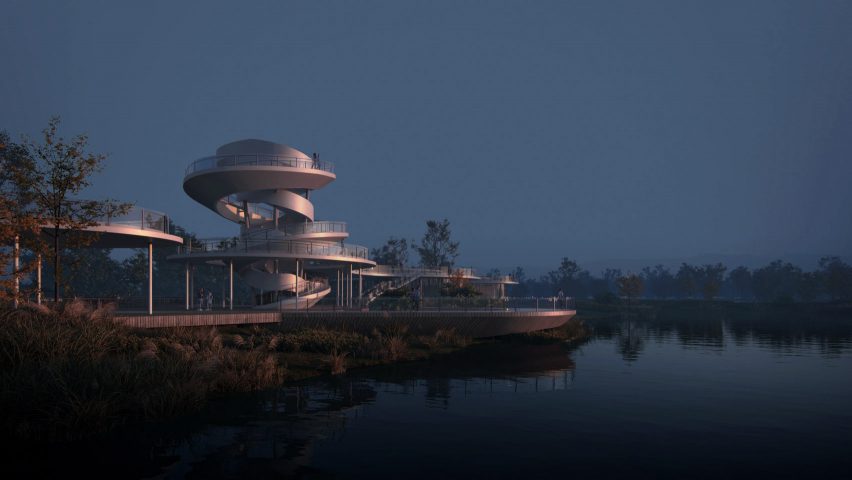As China prepares to celebrate Chinese New Year tomorrow, Dezeen rounds up the 12 most anticipated architecture projects set to complete in the country this year.
China's architecture industry has been hit hard by the commercial property crisis in the past year – and that is reflected in the projects selected below.
With no sign of recovery in sight it is a relatively modest group, often with a focus on integrating with urban and natural fabrics rather than ostentatious mega-structures.
The list includes a sundial-like viewing tower by the coast, a translucent concert hall and renovation of a former cement factory.
Here are 12 buildings to look out for in the Year of the Dragon:
Jinghe New City Culture and Art Centre, Xi'an, by Zaha Hadid Architects
The Jinghe New City Culture & Art Centre in Xi'an will meander over an eight-lane motorway and is intended to emulate the "valleys carved by the Jinghe River through the mountains and landscapes of Shaanxi province".
Designed by UK-based studio Zaha Hadid Architects, it will comprise cultural and recreational facilities interspersed with courtyards and outdoor areas.
Find out more about Jinghe New City Culture and Art Centre ›
Sun Tower, Yantai, by Open Architecture
The design of this 50-metre-high viewing tower in the coastal city of Yantai, by 2023 Dezeen Awards China architect of the year Open Architecture, is informed by a giant sundial.
It will be constructed from two white concrete conical forms connected and braced by horizontal slabs and ramps, containing facilities such as a semi-outdoor theatre, an exhibition space, a library and an observation deck.
Find out more about Sun Tower ›
HKL West Bund Commercial Park, Shanghai, by Group of Architects
This mixed-use development is located on an old industrial site in Shanghai with a 180-metre-long old train station at the centre. The three-span structure is converted into two traverse axes to connect the different programs.
Group of Architects chose a steel truss and wood-grid ceiling to align with the curvy flow of the roof, while the bricks from the old station will be reused on the new facade.
Science City Centre, Guangzhou, by Henn Architekten
In Guangzhou, German architecture firm Henn Architekten designed a set of twin towers of different heights, 150 metres and 80 metres respectively, that are interlocked at their corners.
A hotel lobby at the middle of the higher tower with a continuous amorphous glass surface cuts through the otherwise sharp geometric facade, into the outside corner of the building, while a glazed sky escalator connects the lobby with the conference centre and event hall at the adjunct lower building.
Shanfeng Les Roches School: Cultural Quarter, Shanghai, by Neri&Hu
Located on Shanghai's Chongming Island, this 19,000-square-meter campus will not only be used for educational programmes but also serve as a local cultural community centre with amenities such as an art centre, a black-box theatre, a bookstore, a hotel, retail and restaurants.
In addition, architecture studio Neri&Hu said as much importance has been given to the spaces in between.
Lujiatan Wetland Park visitor centre, Chengdu, by MUDA Architects
The sinuous form of this structure in Chengdu, designed by MUDA Architects, is a direct response to the meandering Jinma River where the project is located. A glass facade is intended to maximise views of the surrounding natural landscape.
The visitor centre also features a wooden walkway that connects to a cantilevered hydrophilic platform on one end, a publicly accessible rooftop and a double-spiral observation tower.
China Philharmonic Concert Hall, Beijing, by MAD
The undulating silver facade of this concert hall designed by MAD is intended to be "reminiscent of a piece of jade".
Once complete, it will become the first permanent residence for China's philharmonic orchestra.
Find out more about China Philharmonic Concert Hall ›
Gate M West Bund Dream Center, Shanghai, by MVRDV
Dutch architecture firm MVRDV is tasked with the masterplan for a riverside leisure and culture district in Shanghai located on a former cement factory. Elevated terraces and a network of bright-orange staircases and elevators will connect a series of industrial buildings.
MVRDV will also design the buildings on the southern half of the site, including a former warehouse with an external staircase finished in orange cladding and orange-tinted glass.
Dameiyong Winery, Tibet, Trace Architecture Office
Located on a steep mountain top in Tibet, this winery is defined by a bowl-shaped volume punctuated by a series of straight lines that divide the space into various functions.
According to Trace Architecture Office, the building will create a cave-like experience inside, while a viewing platform on the rooftop will offer panoramic views of the mountain.
Xi Rang hotel, Wuxi, by Vector Architects
Part of a local tourism development surrounded by mountains and a lake, the Xi Rang hotel by Vector Architects will be arranged into a series of juxtaposed courtyards, an architecture form commonly used in classical gardens in the region.
Semi-outdoor walkways will connect all parts of the hotel on the ground floor under a continuous roof, allowing visitors to stay close to nature even on a rainy day.
Xinhua Fashion City, Chongqing, by Aedas
This 300-metre-tall mixed-use tower in Chongqing will include a bookshop, a cultural plaza, retail space, apartments, offices and a boutique hotel.
A podium connecting to the main tower will house a bookshop and features a facade in the form of unfolding stacks of steps, which Aedas said echoes the mountainous topography of the city.
iFlytek Global Headquarters, Hefei, by Line+
The new headquarters for iFlytek, a Chinese information-technology company known for its research development on artificial intelligence, will accommodate 15,000 staff at one site.
The development has been conceived as a "campus within a park", with four office clusters connected by a continuous terrace and a rooftop running track.

